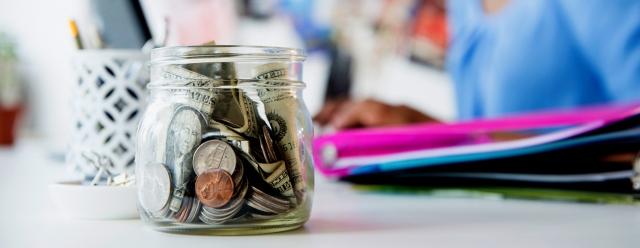Why it matters
- Amid financial uncertainty, the average savings rate has dipped about 3% in the past two years.1
- People are also saving less due to price increases2 and fewer people being in the workforce3 is leaving many having less to spend or save.
- A recent study showed that half of Americans can’t afford a $1,000 expense.4
During times of financial uncertainty, like market downturns, inflation, and even the possibility of a recession, many people choose to access their savings accounts to provide a measure of financial relief. But these days, people are not only spending more of their savings, they’re also saving less. In fact, the average savings rate has gone down about 3% in the past two years.1 Why are people saving less? Well, prices are increasing, so money doesn’t go as far.2 There are also fewer people in the workforce, which leaves many people who aren’t gainfully employed having less to spend or save.3 Despite the downward trend, there are many practical ways to increase savings in the midst of financial challenges.
A great place to start is by spending less. Plan ahead for any major purchases. Try to shop during special promotions or seasonal sales, and use online tools like the Honey or Camelizer browser extensions or phone apps like ShopSavvy to track the best prices. Avoid impulse buys by taking a month to think it over – also known as the 30-Day Rule. Cancel any subscriptions you’re not using, whether it’s a gym membership, streaming service, or even meal kit delivery services.5 Track your spending using pen and paper, smartphone apps, or online software – and be sure there’s more money coming in than going out.
Another way to make it easier to save is to avoid taking on debt. Because one recent study showed that half of Americans can’t afford a $1,000 expense.4 One great way to avoid debt is by having an emergency fund.
What is an emergency fund? According to experts, an ideal emergency fund holds 3–6 months’ worth of salary to help you cover unexpected expenses like car repairs, or medical bills, or even monthly bills should you lose your job. Don’t have one? Start one. Then add to it regularly until you have one month’s worth of salary. Then three months. Then six months.6 Soon you’ll have an emergency fund! Once you have one, then you can consider saving for other things like retirement or a big purchase.
Things to consider
- Spending less with smarter shopping habits can free up money for savings.
- Avoiding debt can make it easier to have money available to put into savings.
- Having an emergency fund can prepare you for life’s unexpected expenses — aim for 3-6 month’s salary.
1 “Personal Saving Rate,” St. Louis Fed (stlouisfed.org), August 2022
2“Why It May Be Particularly Hard for You to Save Money This Year,” Money.com, January 2022
3 “Suze Orman has a warning for those who want to quit in the Great Resignation,” CNBC.com, June 2022
4 “56% of Americans Can't Cover A $1,000 Emergency Expense With Savings,” CNBC.com, January 2022
5 “How to Save Money: 22 Proven Ways,” Nerdwallet.com, April 2022
6“Why an Emergency Fund Is More Important Than Ever,” Investopedia.com, April 2022
Transamerica Resources, Inc. is an Aegon company and is affiliated with various companies which include, but are not limited to, insurance companies and broker dealers. Transamerica Resources, Inc. does not offer insurance products or securities. The information provided is for educational purposes only and should not be construed as insurance, securities, ERISA, tax, investment, legal, medical or financial advice or guidance. Please consult your personal independent professionals for answers to your specific questions.



